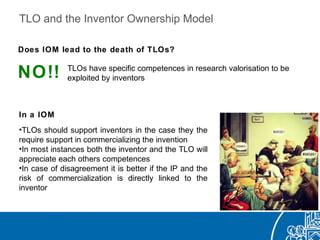TEAM A Lect.3
- 1. Ufficio Valorizzazione Ricerche UVR-SSSA Reconsidering the Bayh-Dole Act and the Current University Invention Ownership Model M. Kenney, D. Patton TEAM A Angela Chiara Francesco Tommaso Ilaria Agostina
- 2. Philosophy before BD Government funded inventions should be freely available to all: •$ 75 billion spent, per year, in government sponsored R&D •Federal government held approximately 28.000 patents •Fewer than 5% of those were licensed to industries for development/commercial product, due to insecurity regarding their ownership Bayh-Dole Act Companies did not have exclusive rights and therefore were reluctant to invest Taxpayers were not benefiting from their contributions What is the Bayh-Dole Act (BD)? An US normative act which provides universities with the right to commercialize employees’ inventions made while engaged in government-funded research (1980)
- 3. Bayh-Dole Act Why the BD in 1980? •Declining of the US productivity •Rising competition from Japan Solving idea Universities are not just learning and research centres but also sources of commercially valuable ideas Policy and goals of the BD •Promote the transfer of the benefits of federal funded research to society •Encourage maximum participation of small business firms •Promote collaboration between commercial concerns and universities
- 4. BD consequences in the different research field Long history of commercialization of university inventions BD was only a formalization of an extant movement Few researchers had any interest in commercializing inventions in biology Due to the revolutionary results in the biotechnology field in the ‘80s, BD found its maximum application Universities soon established Technology Licensing Officies (TLOs) in order to manage intellectual properties through patents, copyrights and trademarks and to take responsibility for commercialization Engineering and chemistry Biology
- 6. It should •expend resources to market and manage the invention •negotiate a license contract with an outside firm But in fact can impede technology transfer because •It is dubiously more effective in search for licensees than the inventor •Often its decision making is driven by money: concentrating on only inventions with clear payoffs could inadvertently limit university research spin- offs •If the inventor wants to form a start-up, he has to pay a fixed fee to the university to use his invention The TLO-inventor relationship: the TLO
- 7. Faculty member Largely immune to direct control and supervision by the administration. Corporate researcher Funds and employment directly controlled by managers Solution Encouraging disclosure by increasing their share of the invention’s income However… Tensions may arise between the inventor and the TLO if the former believes that the TLO is investing insufficient resources in his invention How can the inventor circumvent the university TLO? •Feeding «grey markets» •Establishing a firm to which transfer a patentable «discovery» •Publishing the invention («open source»solution) The TLO-inventor relationship: the INVENTOR
- 8. Non-exclusive Licensing Model Public Disclosure Model IOM Inventor Ownership Model WORM Weaker Ownership Rights Model V S Variants Two alternative models
- 9. Ownership is directly decentralized to the inventors Inventors can decide whether and how commercialize the invention (TLO, themselves, public domain) Value is captured by the inventor, perhaps providing University with an automatic share Inventor Ownership Model (IOM)
- 10. Benefits •No contractual limitation to public disclosure •TLOs’ role in commercializing inventions No obligation to assist in the patenting of the laboratory inventions and their prosecution •No judgment based on the financial returns to University Inventor Ownership Model (IOM) Concerns •Individual benefits based on public funding University may receive a tithe •Exploitation of university duties and resources without sharing costs •Determining ownership between multiple inventors may be difficult •Stifling the flow of information and material
- 11. Does IOM lead to the death of TLOs? In a IOM •TLOs should support inventors in the case they the require support in commercializing the invention •In most instances both the inventor and the TLO will appreciate each others competences •In case of disagreement it is better if the IP and the risk of commercialization is directly linked to the inventor TLO and the Inventor Ownership Model TLOs have specific competences in research valorisation to be exploited by inventorsNO!!
- 12. Requires that all inventions generated through federal support be placed: •on a non-exclusive basis •in the public domain Different results/incentives of the two solutions depend on the industrial sector •Open Source Software: Entrepreneurs use free software to create new firms (IBM) •Pharmaceutical industry: No incentives to develop new compounds due to the lack of a patent full protection. But some exceptions: penicillin and Taxol have been commercialized •Small biotechnology companies might not compete with large ones Both solutions encourage T-T and progress Since non-exclusive licensing is a “tax” and shifts the invention rents from one actor to another, this variant would “socialize” a part of the value of the inventions Weaker Ownership Rights Model Non-exclusive license variant VS Public domain variant
- 13. Schematic comparison of universities ownership regimes
- 14. The University Ownership Model is faulty This model is built around TLOs’ role: Inventors invent, TLOs license and the Licensees commercializes i) Critical relationship between inventor and licensee with TLOs just rent-hunters ii) TLOs usually are unnecessary for the entrepreneurship and the diffusion of university inventions iii) TLOs’ revenues are important for their effectiveness but might become more important then disseminating knowledge Authors suggest to: - Funding agencies could conduct experiments by funding projects in which inventions have to be owned by inventors - Compare these results with current BD model outcomes Conclusion
Editor's Notes
- Cerchi rossi sottolineano simiglianze tra BD e Non-exclusive model Cerchio arancione: Public domain è il più semplice perché rimuove la protezione della IP. Dall’altro lato però non crea incentivo alla commercializzazione e quindi non assicura rendite Cerchi gialli: IMO: L’inventore dedice autonomamente cosa fare ed eventualmente chiede aiuto a TLO. TLO supporta e non gestisce direttamente il processo di commercializzarione















